
Love At First Link: 9 Types Of Backlinks To Consider In Your Strategy
Backlinks are great. They send loads of organic traffic to your site and seriously boost your brand awareness—what’s not to love?
But, because there are so many types of backlinks out there, it can be tricky to identify which ones you need to gain maximum SEO benefits.
With 92% of the top 100 ranking domains having at least one backlink, it’s crucial that you get to know the different types of backlinks so you can rank as high as these pages and reap the rewards.
In this article, we discuss nine different types of backlinks and how to build them so that you can choose which ones to include in your link-building strategy.
Why Are Backlinks So Important?
Backlinks are hyperlinks from one website to another. Think of them as digital referrals: when a website links to yours, their outbound links are essentially vouching for your content.
Search engines like Google see these links as signals of trust and authority. The more high-quality backlinks a website has, the more likely it is to rank higher on search engines.
However, not all backlinks are created equal.
While having backlinks is generally positive, the quality of those links matters more than the quantity. Spammy backlinks from irrelevant or nonauthoritative sites can actually hinder your SEO efforts rather than help them.
Search engines can differentiate between high-quality and low-quality backlinks. They reward sites with strong backlinks while penalizing those associated with questionable practices. These penalties can range from losing your ranking on search engines to being delisted altogether.
🤔 What makes a good backlink?
Here’s what to look for in a quality backlink:
Relevance: The linking site should be relevant to your niche or industry. For example, a backlink from a health blog would be highly valuable for a fitness website.
Authority: High-authority sites pass on more "link juice" to your site, which positively impacts your SEO. Links from well-known publications, respected industry sites, or influential blogs are ideal.
Natural placement: Backlinks should appear naturally within the content. Search engines favor organic, editorial links over those that seem forced or manipulative.
Dofollow status: For a backlink to positively impact your SEO, it must be a dofollow link. Nofollow links don’t pass on SEO value but can still drive traffic. More on this below.
The Different Types of Backlinks That Could Boost Your Search Engine Rankings
Although determining the types of links to build can seem challenging at first, the upside is that there are so many forms of backlinks that there’s something for everyone. This means you can find the perfect balance of links for your brand.
You’re bound to identify links below that will support your business objectives and search engine optimization (SEO) strategy.
It’s worth noting that this isn’t an exhaustive list of all the types of backlinks available. Instead, we’ve narrowed it down to the links that you’re most likely to come across, which are:
Dofollow backlinks: These are hyperlinks that allow search engine bots to crawl a page. They pass on link juice from one website to another. They’re considered a vote of confidence for your website, especially if the linking domains are authoritative websites.
Nofollow backlinks: By using a nofollow tag, website owners use nofollow links to indicate to search engine crawlers that they shouldn’t follow them. This means no link equity will be passed on to the page being linked to.
Sponsored backlinks: These are paid backlinks marked with a rel=“sponsored” attribute. This indicates to search engines that the link was purchased or sponsored. While these links don’t pass on SEO value in the form of link juice, they still drive traffic to your site and build brand awareness.
User-generated content backlinks: These are links created by users and are found in blog comments, forum posts, or social media profiles. While they can be beneficial for driving referral traffic and engagement, they are often nofollow links.
As you can see above—regardless of the type of backlink you choose to build—you’d want your links to be tagged as dofollow to fully benefit from them.
With that said, let’s dive into the different types of backlinks you can build, starting with broken links.
🔗 Broken links
Building broken backlinks is a great way to earn relevant links while helping other websites improve their user experience.
These links aren’t exactly built in the traditional sense—they're link-building opportunities that you uncover.
These are one of the easiest types of links to build because they involve finding broken links on websites that are relevant to your niche and suggesting your content as a replacement—this means it’s highly likely that the website owner will include your link.
➡️ What are they?
A broken link is a hyperlink that no longer directs users to its intended destination. This can happen because:
The page has been moved.
The page has been deleted.
The URL has been changed.
Broken link backlinks are created when a website owner updates these faulty links by replacing them with new links—such as those pointing to your content.
This strategy benefits website owners, link builders, and search engines:
✅ Website owners benefit from an easy way to maintain the quality of their website without having to search for alternatives themselves.
✅ Link builders can acquire high-quality dofollow links from relevant websites without too much effort.
✅ Search engines appreciate this practice because it improves the overall user experience.
➡️ How do they work?
Broken link backlinks direct link juice from the previously broken link to your website.
When a high-authority website replaces a broken link with a link to your content, the authority or "link juice" from that site is transferred to yours.
The more authoritative the original site, the more beneficial the link juice that is passed on.
➡️ How can I build these backlinks?
Broken link building involves a few key steps.
First, you need to identify broken links on high-authority websites that are relevant to your niche. This can be done with SEO tools that scan websites for broken links. Our favorites are:
Ahrefs
Semrush
Moz
Next, you need to have or create content on your site that would serve as a suitable replacement for the broken link. This content should be relevant and of high quality.
Once you have identified a broken link and have relevant content ready, the next step is to reach out to the website owner.
Your outreach should be polite and professional. Explain that you’ve discovered a broken link on their site and offer your content as a replacement.
🔗 Social media links
Social media links don't directly pass on SEO value in the same way that traditional backlinks do because they are typically tagged as nofollow backlinks.
However, social media backlinks offer other benefits like:
Referral traffic
Engagement
Brand awareness
Broader reach
➡️ What are they?
Social media links are any backlinks to your website that are shared across social media platforms.
These links can be included in posts, tweets, bios, and comments, as well as in content shared by your followers.
➡️ How do they work?
Google representatives have stated that social signals like likes, shares, and comments are not direct ranking factors in Google’s algorithm—but many SEO specialists believe they have an indirect impact on your search engine rankings.
Many discussions in the SEO community revolve around the extent to which social media contributes to the way search engines assess a site's authority, relevance, and overall online presence.
Essentially, even though Google may not count social signals as a ranking factor, it doesn't entirely ignore them.
➡️ How can I build these backlinks?
To build social media links, focus on creating high-quality, shareable content that resonates with your audience. This could include blog posts, infographics, videos, and other types of engaging content that users will want to share with their followers.
Along with sharing your content, you should also make sure your social media profiles are optimized with links in key places, including:
Your bios
Your business description
Your posts
Video and content descriptions
🔗 Resource page backlinks
Resource page links come from resource pages, which are web pages that feature lists with valuable resources on a specific topic, such as articles, tools, guides, and more. Here’s an example:
➡️ What are they?
Resource pages are web pages that curate and share high-quality content and tools on a particular subject.
Because resource pages exist to link out to other content, they are excellent opportunities for link building.
When a resource page links to your content, it provides two key benefits:
It helps the page owner by enhancing their content with useful, relevant information that their audience will appreciate.
It provides you with a valuable backlink.
Resource pages are usually well maintained by their owners, who are always on the lookout for new content to include. So, they’re often happy to add links to high-quality resources that align with their niche.
➡️ How do they work?
Resource page backlinks leverage the authority and relevance of the resource page itself.
Because these pages are typically well regarded within their niche, the links they provide are seen as endorsements by search engines.
The effectiveness of resource page backlinks comes from their highly targeted nature. Since these pages are dedicated to specific topics or niches, the links they provide are very relevant to the content they link to.
This is a key factor in how search engines determine the quality of a backlink.
➡️ How can I build these backlinks?
Building resource page backlinks requires a strategic approach, starting with finding relevant resource pages in your niche.
Use advanced Google search strings like “inurl” or “intitle” along with your target keywords to locate these pages. For example:
Healthy eating “inurl:resources”
Healthy eating “best resources”
Healthy eating “useful resources”
Healthy eating “helpful links”
Once you’ve identified potential resource pages, ensure your content is a good fit.
Your content should provide value and align with the topics covered. Creating new content that targets gaps or complements existing resources on the page can increase your chances of securing a link.
Finally, reach out to the website owner with a personalized outreach email and explain why your content would be a valuable addition to their resource page.
🔗 Podcast backlinks
Podcast backlinks are a valuable way to build your backlink profile while also sharing your expertise and gaining exposure in your industry.
These links typically come from podcast show notes or web pages where the host provides additional information about the episode and its guests.
➡️ What are they?
When you participate in a podcast interview, the host usually includes a link to your website in the show notes or on the podcast's web page.
These show notes usually provide a summary of the episode, along with resources and links to the guest’s website or any other relevant content they mentioned during the interview.
These backlinks are extremely valuable because they come from thought leaders within your niche.
➡️ How do they work?
When a podcast host includes a link to your website in their show notes, it provides a direct path for listeners to learn more about you and tells search engines that your site is a valuable resource.
These links are especially powerful if the podcast itself is authoritative or has a strong following.
➡️ How can I build these backlinks?
First, identify relevant podcasts that align with your expertise and target audience. Look for podcasts that regularly feature guest interviews.
Once you have a list of potential podcasts, think about what makes you an interesting guest. If you are well known or have a following in your industry, this will naturally attract interest.
However, even if you’re not a household name in your niche, consider specific achievements or unique insights you can offer.
Next, reach out to podcast hosts with a pitch. Explain why you would be a great fit for their show and what value you can provide to their listeners. Be sure to tailor your pitch by aligning it with the nature of their podcasts. This shows that you’ve done your research and are interested in contributing to their show.
Keep in mind that podcast interviews can be time-consuming, and you will need to prepare some strategies or insights. However, the SEO benefit of receiving a link from a highly authoritative podcast is well worth it.
🔗 Editorial backlinks
Editorial backlinks are a great option for you to consider if you’re looking for a way to build:
Trust with your customers.
Your authority as a brand.
Strong connections within your industry.
They’re also a solid tactic for building relevant, valuable links and creating diversity in your backlink profile.
➡️ What are they?
An editorial link is when a backlink pointing to your site is placed within the content of another web page.
Search engines approve of editorial links. This is because they’re a signal that your website is worth linking to.
Usually, an editorial link is placed in a website’s content at the site owner's discretion.
This means someone has actually thoughtfully and consciously placed a link to your site within their content, which is a nod that your website is worth linking to.
A website owner is more likely to link to your site if they feel that your site or content is:
A valuable addition to their own content.
Informative or that it supports the point they are making.
Provides educational value to their audience.
A way to provide their readers with an expert opinion.
Good enough to support and improve their reader’s experience.
➡️ How do they work?
Much like any other type of backlink, editorial links work in two ways:
A website owner finds your content organically and decides to link to it to improve the quality and value of their content.
You can approach owners of sites that are relevant to your specific niche and ask them to link to you.
This is because having to wait for someone to discover your content and link to it causes a delay as you may have to wait an indefinite period of time for this to happen.
Additionally, your content would already need to be ranking well in search engine results pages (SERPs) for it to be discovered by website owners.
For these reasons, outreach is your best strategy if you want to acquire backlinks like these.
➡️ How can I build these backlinks?
There are three main things you need to focus on if you want to gain backlinks that fall into the editorial category:
Develop high-quality content: The content on your website needs to be impeccable and truly worth linking to. Don’t rush this part of the process. Investing time in developing content that other website owners find irresistible is worthwhile.
Create link-worthy content: Focus on developing content that is shareable in nature. These content types include infographics, detailed research reports, or original studies.
Build relationships: Once your top-notch content is ready to rumble, it’s time to start establishing relationships with journalists, bloggers, influencers, and website owners in your niche. For example, you can start by engaging with them on major social media platforms. If you get the relationship-building part of your strategy right, you should easily land editorial backlinks.
Here’s a high-quality, link-worthy infographic by Hired:
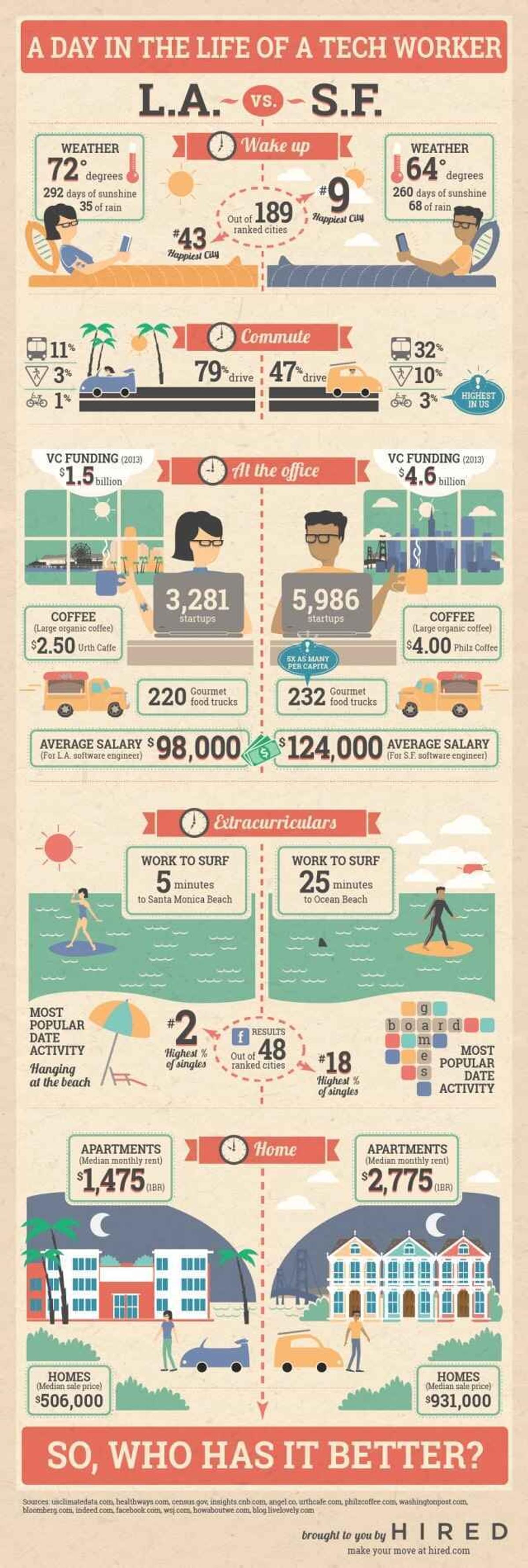
🔗 Guest blogging backlinks
This type of backlink is probably one of the more common ones found in any SEO strategy. Why? Because they’re significantly easier to achieve than spending loads of time trying to get website owners to link to your content organically.
➡️ What are they?
Guest post backlinks are links that you achieve by writing a blog post for a website that publishes guest-written content.
Often, these involve news sites or blogs that invite writers to create this content.
In writing your guest post, you can naturally link to your website.
Guest post backlinks are beneficial to your website in the sense that they typically appear quite naturally—if you’re doing it right, of course—and they provide value to the reader.
Your aim should always be to build high-quality backlinks; guest blogging is a great way to achieve this.
You can find a massive list of guest blogging sites to consider on our blog.
➡️ How do they work?
Websites that publish guest content will often have a section on their site where you can propose or submit content that you’ve written.
Of course, to turn your guest post into a backlink, your content should include a link to your website.
Your guest post links should be directly relevant and appear naturally in the content, providing the reader with added value rather than just driving them to your site for the sake of traffic.
Perhaps the main downside to building these types of links is that they take time, as you will have to create the content yourself.
But this investment in content should pay off in the long run, so it’s well worth the time.
➡️ How can I build these backlinks?
Typically, there are three main things you’ll need to do to get guest blogging right:
Identify sites in your niche: You’ll want to find reputable websites that accept guest posts relevant to your specific niche. Websites that cover almost every topic you could think of, are typically low-quality and basically just a link scheme or private blog network (PBN)—which are dodgy websites built solely for building backlinks. Look for websites with a good reputation and a focused cluster of topics.
Apply or pitch: Once you’ve found the right websites, you need to send them an application or pitch with your idea; also explain why you’re the right person to write a guest post. Your pitch should be clear and to the point, and motivate why your contribution would add value for their readers.
Write epic content and include your backlink: Lastly, you need to create world-class content for your guest post that grabs readers’ attention and gets them to follow your backlink. Make sure that you follow their submission guidelines.
Have a look at the submission portal on a guest blogging website called TechWyse:
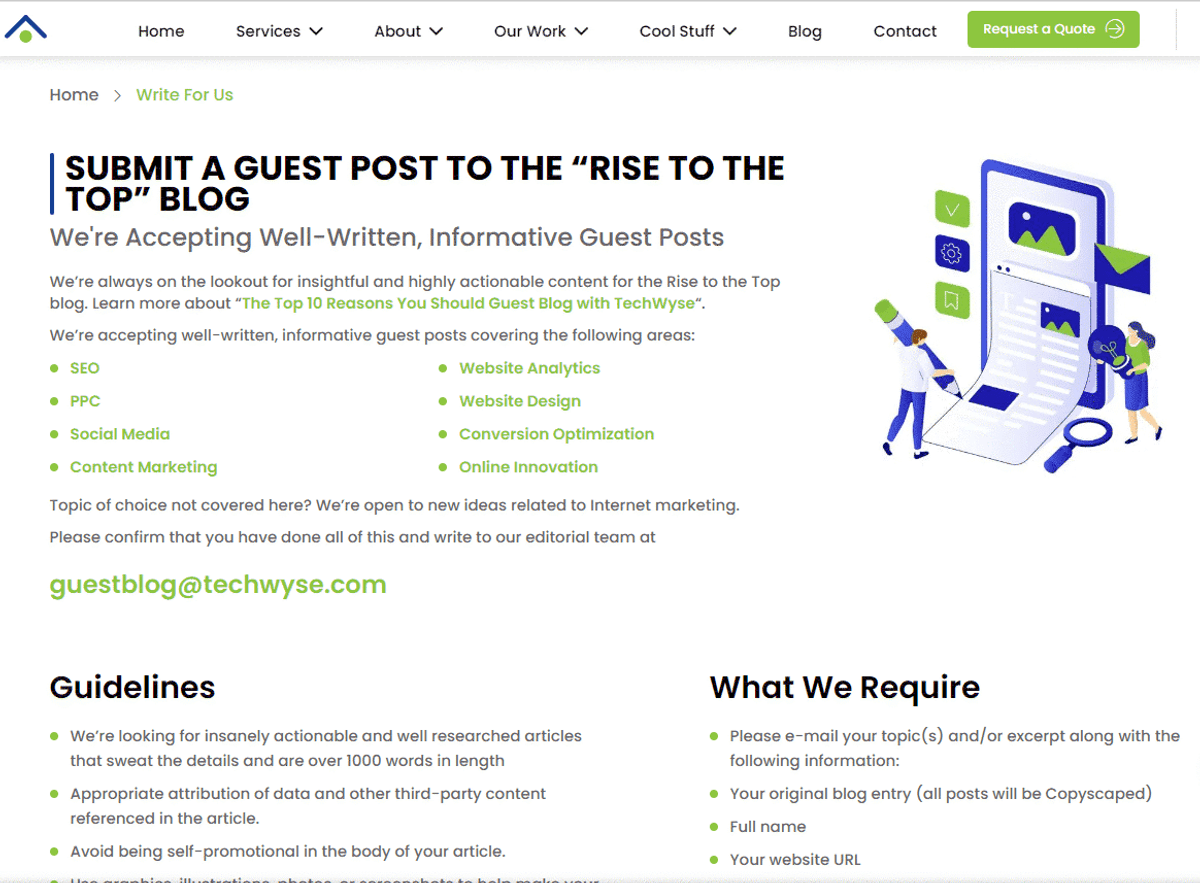
✍️ Placing Your Backlink in a Guest Post
Here are a few pointers for including a backlink to your website in your guest post:
The placement should seem natural and make sense. These are called “contextual links.”
Follow the anchor text best practices outlined in our ultimate guide.
Avoid making your links appear spammy, as this makes it less likely that people will follow your backlink.
Ensure the website tags your backlink as a dofollow backlink.
🔗 Acknowledgment backlinks
This type of backlink is an excellent choice if your strategy is to build credibility and authority in your industry. However, they can be hard to come by if you’re a relatively new business.
➡️ What are they?
Acknowledgment backlinks are when a website or a specific piece of content mentions, credits, or acknowledges you as a source.
They could mention someone in your company who is perceived as an expert on a particular topic, or they could link to your company.
These backlinks are less about promotion and building links, and more about:
Sites showing you or your brand respect or appreciation.
Being referenced and acknowledged.
➡️ How do they work?
These backlinks typically appear in blog posts, articles, news pieces, research, social media posts, podcasts, or even videos. In effect, any form of content can include an acknowledgment backlink.
➡️ How can I build these backlinks?
Building your reputation is the most important part of gaining this type of backlink. Interact daily on social media, relevant industry forums, and any other platforms that work for your niche.
The more people get to see your content, the more likely it is that you’ll get acknowledged in their work.
🤔 What are Guest Post Bio Backlinks?
Did you know that you can earn acknowledgment backlinks through guest blogging?
Often, guest blogging sites allow an author (you) to include a bio on their website or within the content you write for them.
Usually, a guest post bio will allow you to include a link that points to your website.
And just like that, you have an acknowledgment link that gives you credibility, both in your industry and in the eyes of search engines.

🔗 Paid backlinks
Often, when link-building efforts aren’t going well, and you just aren’t seeing results, link builders will turn to the practice of buying links. Paid links are a great way to boost your backlink profile and achieve results fast.
⚠️ A Quick Word on Paid Backlinks
Before we go any further in our discussion on buying links, we must warn you up front that Google’s algorithm isn’t a fan of paid links. This is because they view it as an attempt to manipulate your rankings. Failing to handle the paid backlinks process carefully can result in a Google penalty.
A Google penalty or manual action is when a human reviewer deems your paid links as breaking their Webmaster Guidelines (now referred to as Google Search Essentials) and manipulating the search engine.
Usually, manual actions only occur when reviewers believe you are purposefully manipulating Google to rank your page higher in search results through underhanded practices.
➡️ What are they?
Like any backlink, these are links on a website that point to your own site. The difference is that you have paid for them.
The benefits of paid links are pretty obvious: you acquire backlinks quickly and without much effort, which is great—if done right! Avoid spammy links and dodgy link-building practices that focus on quantity rather than quality.
➡️ How do they work?
First, let’s look at the difference between paying a website owner and paying a service provider for links:
Paying a website: Many website owners know just how valuable a backlink is these days, which is why they’re happy to accept money in return for placing a link to your website in their content.
Paying a service: A professional link-building service will typically use the best and most above-board tactics to build links for you.
➡️ How can I build these backlinks?
Paying a website owner for a backlink is a relatively straightforward process:
You find a website or provider that’s offering paid links.
You negotiate a price with them.
You and the website owner decide on details such as your anchor text and the specific page where your link will be placed.
You’ll then need to pay them, and your link will (usually) go live within a couple of hours.
There is a lot more to the world of paid links. We suggest you read our full guide on buying links so you can truly benefit from your new paid backlinks.
🔗 Press release backlinks
Digital public relations (PR) is a robust way to build links, and it can immensely impact your online brand awareness.
Digital PR agencies and professionals are experts at building links through press releases.
A great thing about press releases is that they don’t just appear in search results, they may also be listed on Google News:
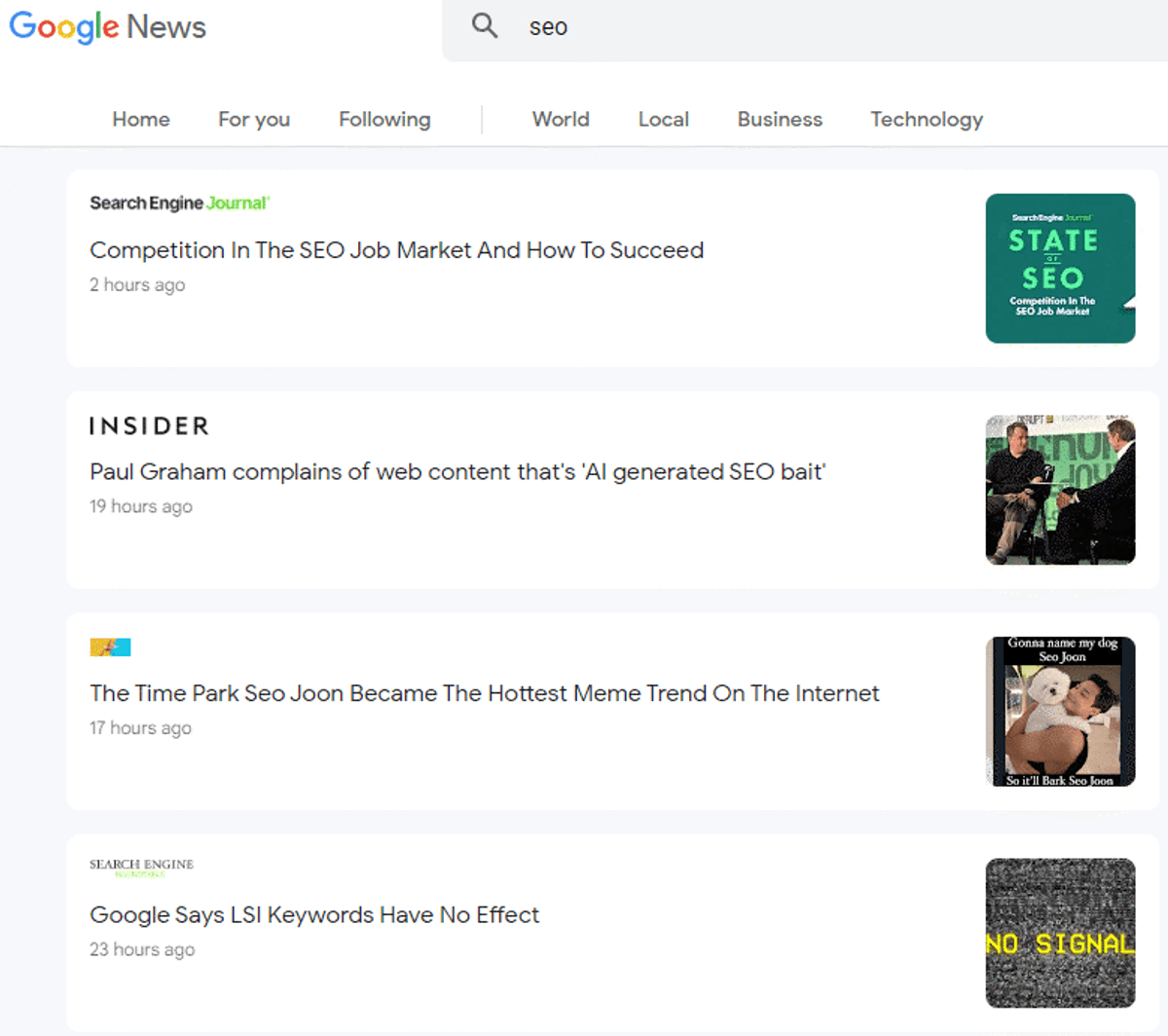
➡️ What are they?
Press release backlinks are when you or your PR agency issues a press release that, when published, contains a link to your website.
These releases are often part of a tactic called newsjacking. This is when a brand jumps on a hot news topic and adds an expert opinion or advice. This is a bit of a piggyback move, but it’s a great way to use press releases to your advantage.
➡️ How do they work?
These releases are typically distributed to online media outlets, press release distribution services, or news websites.
The idea is that in the press release, your brand or website would be positioned as an authoritative source and this would encourage readers to visit your site.
Additionally, news outlets may pick up on your press release and either:
Publish it in its entirety: Some media houses publish press releases as is, which will include your backlink. This is a beneficial scenario because you get backlinks from a highly authoritative website.
Use quotes from it: A journalist may come across your press release and publish parts or quotes from it to back up a story they are writing. They may see the backlink in your release and include it in their piece, or you can approach them to do so once they’ve published their story
🤝 Reaching Out to Journalists to Include Your Backlink
If you’ve issued a press release that a journalist quoted as a source in an original piece of online content, you can pretty much jump for joy. You’ve just opened the door to potentially earning a backlink on a major website with loads of authority.
A problem that might arise is when they haven’t included your link in their content. This is called an unlinked mention.
The best way to handle this situation is to approach them and explain the value they would add to their article if they included your backlink.
Be sure to keep this conversation professional and polite!
➡️ How can I build these backlinks?
There are a few steps you’d need to follow to acquire press release backlinks. Of course, if you work with a digital PR firm, they can handle most of the steps we’ve mentioned below on your behalf:
Create a press release: The copy in your release should be extremely well written with no spelling mistakes or grammatical errors. It should be high-quality content that adds value and engages the reader.
Distribute it: Choose a reputable press release distribution platform or service. Many of these are paid platforms, but it’s well worth the investment if your release gets picked up by a major news source.
Publication and syndication: Ideally, news websites and other publication platforms will publish your press release as an article or blog post.
💡 Our Top Tips for Writing Excellent Press Releases:
Your release must naturally be newsworthy and should genuinely add value, especially if your niche is already drowning in information on the topic.
Use keywords that are relevant to your brand and niche to improve your chances of ranking in the SERPs.
Ensure the backlinks you include take the reader to the exact page or piece of content that will back up the information in your release.
As part of your link-building efforts, spend time building relationships with journalists and bloggers. When you have a press release you want published, you can then reach out to them because you have already established a relationship.
🔗 Comment backlinks
This link-building tactic is when you include your backlink in a comment on a blog post or news article.
However, it’s worth noting that Google and other search engines usually ignore blog comment backlinks. This is because this has long been a spammy tactic that link builders use to achieve backlinks quickly and with ease.
➡️ What are they?
Bloggers and news site owners often enable a comments section in their website design to allow people to share their views and opinions on the content they’ve published.
These comment sections are often moderated, and not all of them allow people to post links in their feedback.
➡️ How do they work?
By posting a comment with a link to your website on a blog or news site, you’ve earned a backlink.
Check out this comment on a blog post published by ProBlogger:
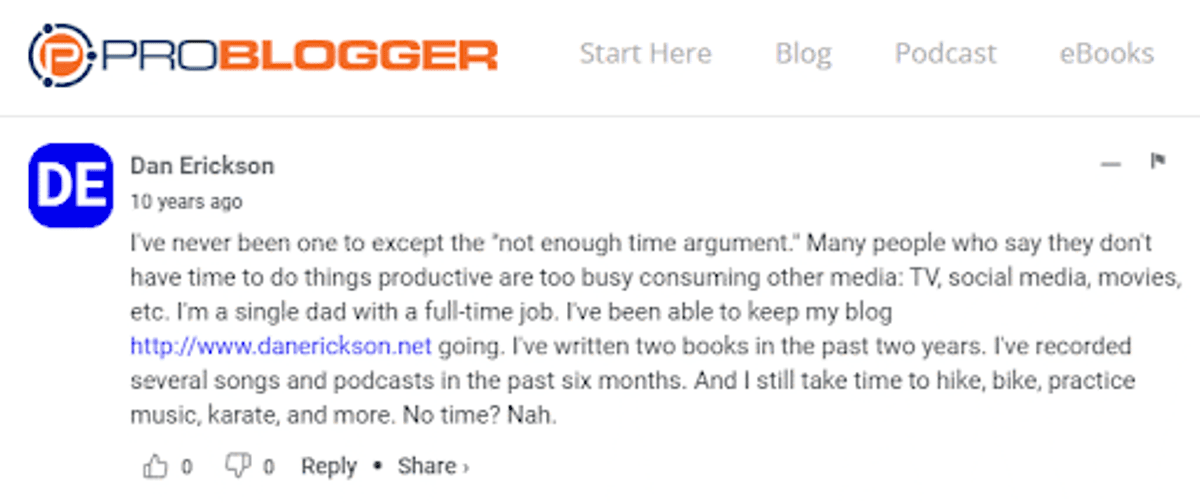
You can also apply this same methodology on review sites as a way to acquire links.
While it is certainly a tactic worth considering, this type of link building should be done ethically and with caution.
➡️ How can I build these backlinks?
The first rule of blog comment links is to ensure you’re not coming across as being spammy. For this reason, you should:
Only comment on blogs that are hyper-relevant to your niche.
Avoid excessive self-promotion.
Respect the website’s policies on comments.
Write quality and thoughtful comments that add value for readers.
It’s very easy for a blog comment to seem spammy, so be sure to err on the side of caution here.
🔗 Niche edit backlinks
If creating original and well-written content isn’t your specialty, niche edit backlinks may be something to consider adding to your strategy.
➡️ What are they?
Also referred to as link insertions or curated backlinks, niche edits are when links are placed in a piece of existing content that is relevant to your niche or industry.
➡️ How do they work?
Rather than creating new content, this tactic involves carefully seeking out existing news articles or blog posts, and asking their owners to include a link to your website in content they’ve already written.
You would need to research and look for websites with content that is relevant to your brand and what you want to promote. Remember, good backlinks are those that appear in a place where you would expect them to be found—in a natural way.
You can use SEO tools like Ahrefs to find articles and blog posts that are currently ranking well, or search within industry-specific communities like groups on LinkedIn.
➡️ How can I build these backlinks?
Once you’ve identified a website that you feel is ideal for a niche edit backlink, you’ll need to contact the owner or author of the content through outreach.
Your outreach has to strongly and clearly communicate how adding your backlink will add value to and elevate their content. You’ll need to emphasize how a link to your website could enhance their readers’ experience on their site.
🔗 Reciprocal backlinks
If you have spent time building relationships with other people in your niche or industry, then it becomes a lot easier to build this type of backlink.
➡️ What are they?
Often referred to as link exchanges or swaps, reciprocal links occur when one or more website owners agree to link to each other’s content.
In other words, you link to their content, and, in return, they link to yours.
❌ Avoid Excessive Reciprocal Linking
Remember what we said earlier about Google penalties? When done to the extreme, reciprocal linking can quickly land you in hot water with search engines.
Search engines could view excessive link exchanges as attempts to manipulate your rankings through malicious tactics.
We’d recommend about two to three link exchanges per month to avoid any negative consequences.
➡️ How do they work?
Ideally, you would rely on a relationship you already have to reach a mutually beneficial agreement to swap links.
Once you’ve both agreed to an exchange, you’ll either need to create the content where the link will be placed, or add the link to existing content as per your agreement.
➡️ How can I build these backlinks?
Building relationships where you can suggest such an agreement can take time. This tactic can be challenging if you haven’t built a name for yourself in your industry yet.
However, if you do have relationships with industry players who are willing to help you (and help themselves in the process), then this is a tactic you may want to explore in your link-building efforts.
🔗 Directory backlinks
This is another link-building tactic that link builders abused significantly in the past, especially around the time when SEO first became common practice.
As a result, Google nowadays often ignores backlinks that stem from directories. Irrelevant directory links are viewed as nothing other than spammy backlinks.
However, super relevant and well-placed links in professional industry directories may just land you on Google’s good side.
➡️ What are they?
This type of backlink is when you approach a (professional and reputable) online directory and ask them to list your business information on their platform.
Most directories will include a link to your website in your business listing.
Some directories let you upload a listing yourself, although these are more likely to be one of those spammy ones we spoke about earlier.
➡️ How do they work?
If the directory you’ve chosen is truly reputable, you’ll have to go through a process to earn your backlink.
Typically, you’ll have to make a submission that is good enough for the directory to consider it as a valuable addition to their platform and its users.
These submissions are usually reviewed to ensure they meet the directory’s requirements. If approved, your listing will be published on the directory website with a link to your site.
➡️ How can I build these backlinks?
There are a few simple steps to follow to go about directory backlinks in the right way.
Identify relevant directories: Again, you’ll want to find directories that are worth their salt and that are extremely relevant to your business.
Create a compelling listing: Your listing needs to be targeted and attract attention so that readers will actually follow your backlink.
Follow guidelines closely: Before submitting, double-check that you’re following the directory’s exact guidelines.
Use descriptive anchor text: Many directories allow you to choose the anchor text you use for your listing. Be sure to use descriptive anchor text that accurately represents your website. Avoid spammy anchor text practices at all costs.
Here’s a business listing on a reputable directory called Better Business Bureau:
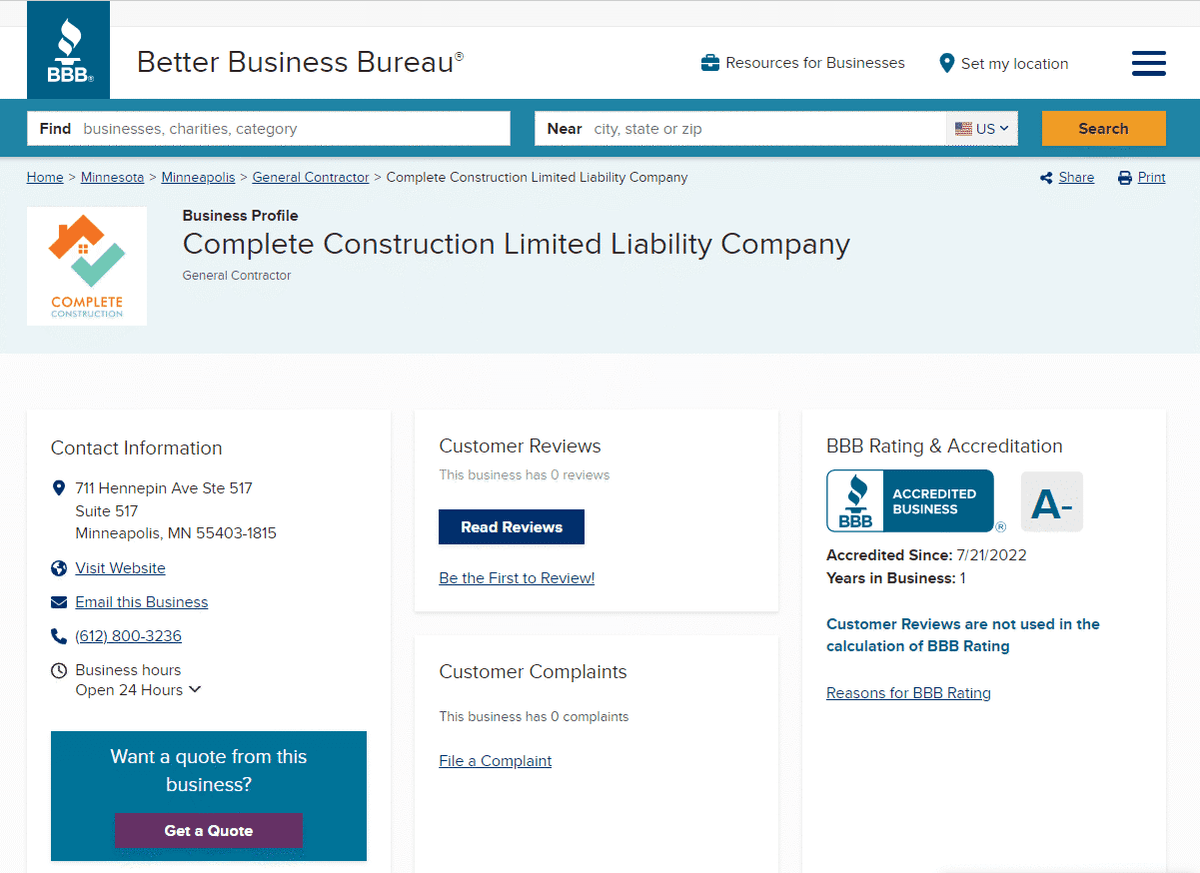
Three Types of Links to Avoid
When it comes to building backlinks, always choose quality over quantity. Here are three types of links you should avoid at all costs:
❌ Sitewide links
Sitewide links are hyperlinks that appear on every page of a website. They include footer links, sidebar links, and header links.
There’s nothing wrong with these links when used for their intended purpose. We use sitewide links at LinkBuilder to help users easily navigate between sections of our website:
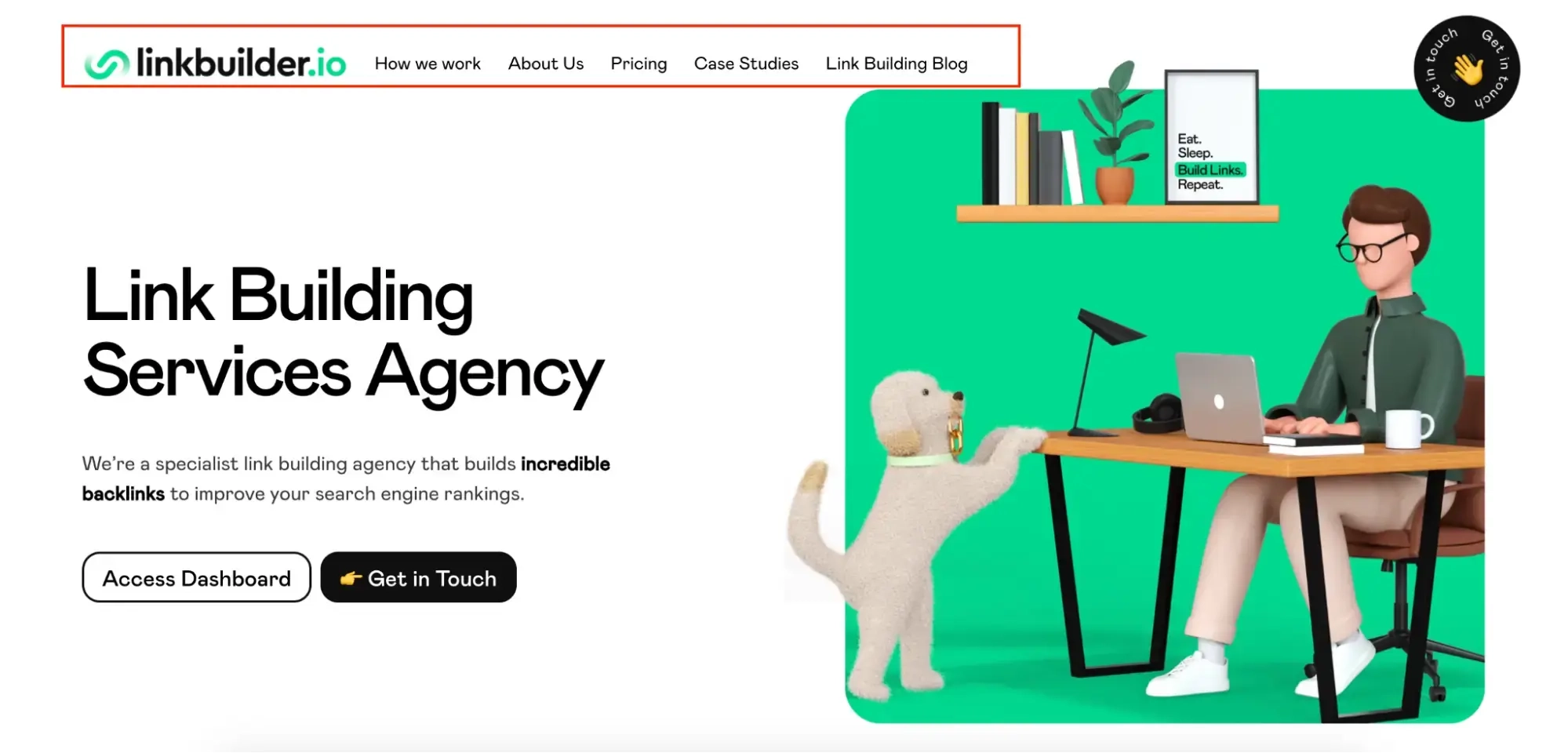
The problem arises when these links are used for SEO purposes rather than genuine navigation.
When sitewide links are used to boost a page's search engine ranking, they appear manipulative to search engines.
This is especially problematic if the links point to external websites with no clear relevance to the content or purpose of the site they're on.
❌ Spammy links
Spammy links are links placed on irrelevant forums, directories, or blog comments:

These links are often automated or created without any engagement or relevance to the content of the websites they appear on.
Search engines are adept at identifying spammy link patterns and can penalize websites that participate in such tactics. This can lead to a drop in rankings or even a Google penalty.
❌ PBNs and link farms
Private blog networks (PBNs) and link farms are networks of websites created specifically for the purpose of link building.
They exist solely to artificially inflate a website’s backlink profile by creating numerous low-quality links. These link schemes violate Google’s Search Essentials guidelines and are considered black-hat SEO tactics.
Using PBNs and link farms can result in severe penalties from search engines, including complete removal from search results. This can devastate your site’s online visibility and traffic.
Wrapping Up on Different Types of Backlinks
With so many different types of backlinks to choose from, it can be challenging to figure out where to place your focus.
While most of these links can boost your search rankings, it’s difficult to know what’s right for your brand.
Here at LinkBuilder, we know exactly how to determine which links best match your business objectives.
We make it our business to get to know your brand inside and out, and we then develop a hyper-focused strategy based on the specific types of backlinks that will drive growth.
If you’re interested in working with an agency with the experience to know the types of backlinks that’ll work for you, visit our website to get in touch. We’d love to help!

